Looking for options for buying your next camping tent? Either is for a night out in the back yard with friends, need to spend a day out with boy scouts or a trip to a camping site, the most commonly asked questions for starts is: What types of tents are there? What is the main difference between the types of the tents? Well, if you are new and asking the same question, then you don’t need to worry much about it. It is not as difficult or complicated. What is important is that you know the basic 4 types of tents available in the market so you make the right decision in buying the tent that suits your requirement the best.
When it comes to camping, having the right tent can make all the difference in the world. With so many different types of tents to choose from, it can be challenging to know which one is right for your camping needs. In this article, we’ll take a look at four of the most popular camping tent types: dome tents, instant tents, cabin tents, and canopy tents.
How many types of tents are there?
Well, to be honest there are a lot of types of tents available for home use so we will make it easier for you and discuss the main and most famous four types of camping tents in this article. You can have a look at all the different types of the camping tents in our types of camping tents blog.
Most Common 4 Types of Tents (Summary)
 |
Dome Tents |
 |
Instant Tent / Popup Tent |
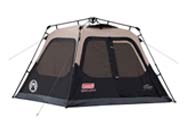 |
Cabin Tent |
 |
Canopy Tent |
Comparison of 4 Types of camping Tents
Here’s a comparison table for the four types of camping tents:
| Tent Type | Pros | Cons | Best For |
|---|---|---|---|
| Dome Tents | Easy to set up, good ventilation, balance of space and weight | Limited headroom, may not be ideal for tall campers | Families and groups, a variety of sizes available |
| Instant Tent / Popup Tent | Incredibly easy to set up, time-saving | Limited size options, not always durable | New campers or those looking for convenience, small groups |
| Cabin Tents | Spacious, room dividers for privacy, separate living areas | Heavy, bulkier to transport and set up | Families or groups who prioritize comfort and space |
| Canopy Tents | Wide-open design, shelter from sun and rain | Limited privacy, not ideal for high winds | Large groups or events, central gathering point at a campsite |
This table highlights the key advantages and disadvantages of each tent type and provides a general idea of the best use case for each type of tent. Keep in mind that these are generalizations and that specific tent models may vary in terms of their features, durability, and suitability for different situations.
Good and worst brands for 4 types of tents
here’s a table that lists some good and bad brands for each of the four tent types, along with the reasons for their inclusion:
| Tent Type | Good Brands | Reason | Bad Brands | Reason |
|---|---|---|---|---|
| Dome Tents | REI, Big Agnes, Marmot | Durable, high-quality materials, good ventilation | Coleman | Lower quality materials, not as durable |
| Instant Tent / Popup Tent | Coleman, Ozark Trail, Core | Easy setup, affordable | Wenzel | Poor durability, not as easy to set up |
| Cabin Tents | Eureka, Coleman, Browning Camping | Roomy, separate living areas, sturdy construction | Ozark Trail | Poor quality, not as durable |
| Canopy Tents | E-Z UP, Coleman, Caravan Canopy | Durable, good sun and rain protection | Caddis Sports | Poor quality materials, not as sturdy |
Note that this is not an exhaustive list of all tent brands and that individual tent models within a brand can vary in terms of quality and features. This table is intended as a starting point for researching tent brands and models within each category.
1. Dome Tents
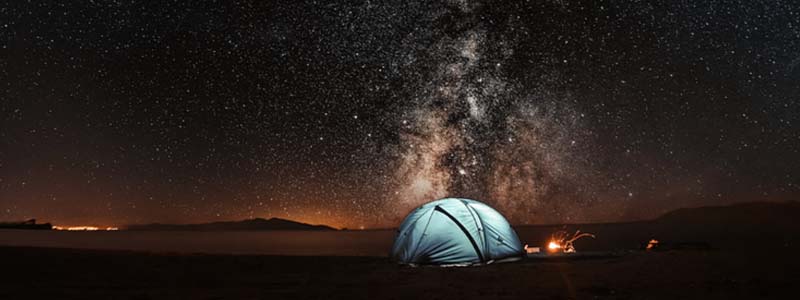
Dome tents are one of the most popular types of camping tents due to their ease of setup and versatility. They are freestanding and typically have two or more poles that cross in the middle to create a dome shape. Dome tents come in a variety of sizes, from small two-person tents to larger family-sized tents that can accommodate six or more people. They are also designed to withstand harsh weather conditions and provide excellent ventilation, making them an excellent choice for camping in a variety of environments.
Dome tent is the most famous type of tent for the campers mainly due to its light weight and natural spherical aerodynamic design. Let’s look at the salient features of this type of tent so you can have a better idea about dome tents.
- Is dome tent light-weight?
Dome tents are light-weight which makes it an ideal choice for most people who want to carry the tent along when hiking, trekking, camping, fishing, backpacking or car camping.
- Does dome tent have low ceiling?
The dome structure has slanting walls which are good for aerodynamics and give many advantages, however, one major disadvantage comes with the low height of the ceiling for dome tents. Generally, the dome tents are made so that the campers can sleep in the tent, while focus is on the small size and light weight. Don’t expect that these will be high enough for you to stand in the tent. The most common height of dome tents for 2-6 people range from about 3.5 feet to 4.5 feet. Do check the exact dimensions of the tent you plan to buy for the exact dimensions.
- Are dome tents small in size?
As I said earlier, the dome tents are generally focused on optimizing the weight, they are not famous for being spacious. Dome tents are usually smaller in size and give just about the space for the campers to sleep in sleeping bags.
- Is dome tent frame strong?
Dome tents are generally designed to have 1 or 2 poles. Conceptually, the more poles you have, the stronger your tent is. However, since these are small light-weight tents, one or two poles is enough for the structure. You can have the guy lines for additional protection as well.
- What is setup time for dome tent?
Dome tents can be setup fairly quickly. The exact time to setup depends on the size and the model of the tent but most of the common dome tents for 4-persons can be setup in under 5 minutes with the help of two people. Most of the tents come with setting up manuals that are fairly easy to follow and remember. Some often come with color coded poles and hoops so you don’t mix up the assembling part. To summarize, it is not difficult to set up dome tents and after a little practice, you can do it alone as well. We always recommend that you try to setup up the tent once at home before you take it for the final trip.
List of some best Dome tents
| Preview | Product | Rating | Price | |
|---|---|---|---|---|

|
Coleman Sundome Tent | Buy on Amazon | ||

|
Coleman Evanston Screened Camping Tent, 6/8 Person Weatherproof Tent with Roomy Interior Includes... | 3,263 Reviews | $175.00 | Buy on Amazon |
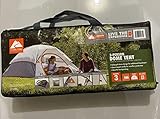
|
Ozark Trail, 3 Person Camping Dome Tent | $49.99 | Buy on Amazon | |

|
Ozark Trail 22 piece Camping Combo Set | 40 Reviews | $200.83 | Buy on Amazon |
2. Instant Tents or Popup Tents
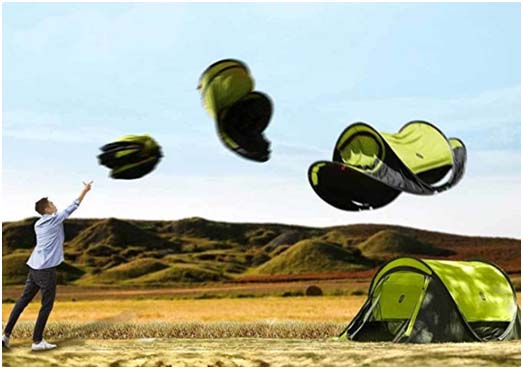
If you’re looking for a camping tent that is easy to set up, look no further than an instant tent, also known as a popup tent. These tents are designed to be set up in minutes, making them a great choice for camping trips where time is of the essence. Instant tents typically come with pre-attached poles that can be extended and locked into place with minimal effort. These tents are available in a variety of sizes and are ideal for weekend camping trips or festivals where you need a quick and easy shelter.
Instant tent (or called pop-up tent) have recently been very famous among the campers. As the name suggests, they are instant tents and safely are the fastest tents to setup. Let’s check out their important features so you can decide if these align with your requirements.
- Is instant light light-weight?
Instant tents are light-weight tents as well just like dome tents. Light weight tents don’t have large space, multi-rooms and screen rooms etc. but are definitely good for small number of people who need to travel light while they go on hiking or camping.
- How high is instant tent ceiling?
Just like dome tents, the instant/popup tents also have low ceilings which comes with the fact that these are usually small tents for up-to 4/6 people. However, that only prohibits you from standing in the tent. Not everyone needs to stand in the tent so it is fairly a decent choice that does not concern most of the people.
- Are all instant tents small in size?
Instant/Popup tents are made to be carried on the campers back for long time and can be setup with one person quickly. Small size is their main trait. If you are looking for a family tent or a tent which has room for your gears, family or maybe a pet, then this type of tent may not he an ideal choice for you.
- Is instant tent’s frame strong?
Popup/instant tents are pre-assembled. The frame usually includes multiple aluminum poles which are covered with fabric and you really don’t have to worry about understanding the corners, colors or poles since everything is already in its place.
- Does it really take seconds to setup instant (popup) tent?
Pre-assembled frame allows you to setup the instant tent within seconds. You just need to open the tent and stretch it outwards and that’s pretty much it. Most of the tents come with easy to understand manual that should be enough to read once and you will be good to go. This is the most exciting feature that sets it apart from all other tent types.
List of some best instant tents or popup tents
| Preview | Product | Rating | Price | |
|---|---|---|---|---|

|
Coleman Weathertec Instant Camping Tent - Available in 4/6/8/10 Person Sizes | 8,555 Reviews | $114.00 | Buy on Amazon |

|
Ozark Trail 6-Person Dark Rest Instant Cabin Tent | 67 Reviews | $141.66 | Buy on Amazon |

|
Ozark Trail 10' x 9' Instant Dome Tent, Sleeps 6 | 20 Reviews | $99.96 | Buy on Amazon |

|
6 Person Easy Pop Up Tents for Camping - AYAMAYA Double Layer Waterproof Instant Tent with Vestibule... | $139.99 | Buy on Amazon |
3. Cabin Tents

Cabin tents are designed to provide spacious and comfortable accommodation for larger groups. These tents are typically larger and heavier than other camping tents, and they offer plenty of headroom and space for multiple people to move around. Cabin tents come with features like room dividers, multiple doors and windows, and even built-in lighting systems. They are ideal for car camping trips or extended camping trips where comfort is a priority.
Cabin tent is a very successful design which has be exploited and modified in various aspects by the leading manufacturers. Cabin tents are usually larger than dome and instant tents and are meant to accommodate a group of people. Let’s check out their main features quickly.
- Are cabin tents heavy?
Cabin tents are large tents and generally weigh from anywhere between 10 up to 80 pounds or even more. Cabin tents are not ideal for backpacking or travelling or hiking long distances are usually medium to heavy-weight.
- How tall is a cabin tent?
Cabin tents have high ceilings. Most of the cabin tents are high enough for a tall person to stand in the middle of tent. Cabin tents walls are vertical which gives the required height and space. If you plan to stay inside of camp for long durations, cabin tent is the type best suited for you. You stay in the tent, stand, stretch and not get tired in bad weather.
- How large are cabin tents?
Cabin tents have vertical walls which give you more space than dome, sphere or instant tents. You can always use the extra space for your equipment and luggage. Cabin tents can accommodate from 4 up-to 14 people. Some of the cabin tents can accommodate even more people.
- Does cabin tent have multiple rooms?
Some of the large cabin tents also come with detachable dividers that lets you have privacy of rooms in your tent. This is ideal for a group of people or if you have pets and want a divider in between. Some multi-room cabin tents also have separate doors for each room that is more another convenience and you can move freely in and out of the tent without worrying to disturb your fellow campers.
- Is cabin tent frame strong?
Cabin tents come with variety of designs and materials. Most common are aluminum and steel frames. Aluminum frame is lighter and flexible whereas the steel is harder yet gives more strength. Cabin tents have multiple poles and at times complex structure.
- How long does it take to setup cabin tent?
Cabin tents can take anywhere from a few minutes up to an hour to setup depending upon the size and design. Cabin tents need to be assembled at the camp site. You can easily find a lot of tent setup videos that can guide you on all the steps of assembling. You can also follow the instruction manual that comes with the tent. I suggest you assemble and test the tent once in your back yard before going to the camp site. Depending on the size of the tent, it can be sometimes tricky to setup the tent alone so I recommend at least 2 people take the responsibility to setup the tent.
List of best recommended cabin tents
| Preview | Product | Rating | Price | |
|---|---|---|---|---|

|
Coleman WeatherMaster Camping Tent with Screened Porch, Weatherproof 6-Person Family Tent with... | 2,615 Reviews | $260.33 | Buy on Amazon |
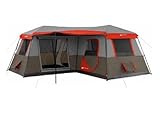
|
Ozark Trail 16x16-Feet 12-Person 3 Room Instant Cabin Tent with Pre-Attached Poles | 246 Reviews | $369.50 | Buy on Amazon |

|
Eureka Copper Canyon 12 -Person Tent | $557.72 | Buy on Amazon | |

|
Ozark Trail 10-Person Dark Rest Instant Cabin Tent | 108 Reviews | $297.00 | Buy on Amazon |
4. Canopy Tents
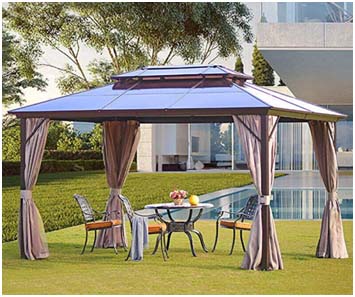
Canopy tents are a popular choice for outdoor events like barbecues, parties, or festivals. These tents are typically larger and provide an open and airy shelter, perfect for hosting large groups of people. Canopy tents are easy to set up and take down, and they come in a variety of sizes and designs. They are also designed to provide shade and shelter from the sun, making them an ideal choice for outdoor events during the summer months.
Canopy tents are completely different type of tent. Canopy tents are open tent shades which are large enough to have seating underneath. These are not protective against severe bad weathers. Canopy tents are idea for picnics, beaches, farmer markets, booths or stalls.
There are some hybrid tents that can cross over between a dome and a canopy, but we will stick to the main 4 types of tents in this blog.
- Are canopy tents heavy?
Canopy tents are medium to heavy-weight and are not meant to be carried for hiking or camping. Most of the canopy tents come with nice carry bag but always have a look at the weight so you know which ones are good enough to be carried to beaches. Most canopy tents are heavy and are intended to be setup at one place for some days before taking them apart.
- How high is a canopy tent?
Canopy tents have high ceilings and these are made for people to stand or sit underneath them.
- How large is a canopy tent?
Typically canopy tents start from a 10 feet side which is pretty big as compared to other tents.
- Does canopy tent have side walls?
Some canopy tents do have side walls, others don’t. Some of the canopy tents are made in such a way that they are meant to be attached with other canopy tents and have one sided wall. Keep an eye on the side walls if you are looking into canopy tents.
- Is canopy tent frame strong?
Canopy tents have aluminum or steel frame. If it is aluminum, always go for the powder coated aluminum poles since they have protection against rust and bad weather. If you are looking into side walls, try to get the products which offer zippers on the walls which makes is way easier to attach/detach the privacy wall.
- How long does it take to setup a canopy tent?
Canopy tents setup time varies a lot depending on what product you plan to buy. Some of the canopy tents require a lot of work to erect the poles and attach the fabric while some come with pre-attached fabric and easy to setup design. Make sure you can get sand from somewhere close if you are not camping on beach, because most of the canopy tents come with sand bags that need to be filled with sand. Also, I recommend you to take extra-long steel stakes if you intend to setup canopy tent on the beach.
List of best recommended canopy tents
Other Types of Tents for Camping
We discussed four main types of camping tents. There are a number of other types of tents and then variations of each type. Some of the common tent types are:
- Dome tent (discussed above)
- Instant or Popup tent (discussed above)
- Cabin tent (discussed above)
- Canopy tent (discussed above)
- Geodesic tent
- Hoop tent
- Ridge / A-frame / pyramid tent
- Tunnel tent
- Bell Tent
- Sphere / igloo tent
You can learn more about other tent types at our detailed types of camping tents blog as well.
Conclusion
I think by now, you will have a good understanding of the common tent types specially 4 types of tents and their pros and cons. If you are camping alone and want to travel light, you should go for dome or instant/popup tent. If you want to travel with family and friends and want to stay together in the camp and have fun, you should go for a large cabin tent.
We have a bunch of other information blogs that can help you making the right choice when you are buying camping tents and accessories. You may want to go through these which relate to you for a quick overview.
The Fascinating History of Camping Tents
From Nomadic Living to Battlefields
Centuries ago, many people lived nomadic lifestyles, roamed within a certain range, and traveled on a seasonal basis to avoid extreme weather conditions. They needed portable homes, which they created from the hides of animals that they hunted for food. The hides were cleaned, cured, and stretched to provide material for clothing, footwear, and homes. The fabric was stitched together and stretched over wooden poles to create individual structures within which families could sleep and be protected from the elements and nocturnal predators. These were the earliest tents, dating back to Biblical times.
When military units were established and had the need to travel for battle, these portable structures were adopted to protect the men. Teepees were the first type of tents used by the North American armies, a style learned from early Native Americans.
Modernization of Camping Tents
Tents remained rustic and basic until the mid-1900s, when people started showing interest in travel to colder climates. To withstand the elements, tents underwent restructuring of the fabrics and designs, making them bulkier and heavier.
Camping Tents for Recreational Use
Between the 1960s and 1970s, camping became a popular recreational activity, and tents changed once again to meet this newer need. Lighter aluminum poles replaced heavier wooden poles, making it easier to tote and set up the tents.
Continuous Development
As camping grew in popularity, people started coming up with more and more ideas to make the experience even more satisfying. Tents continued to be improved upon over and over again, resulting in the type of structures available today for camping enthusiasts. The development of tents continues to this day, with additional features being included with every passing year. From the initial invention of animal hides stretched across wooden poles, people can now choose between one to six room tents, tents with built-in lighting, tents with hinged exterior doors, and more.
The history of tents goes back nearly to the beginning of time when man sought some structure with the materials at hand to protect himself from the elements. Now, they are used for enjoyable sojourns into the great outdoors, equipped with many of the comforts of home.
- The earliest tents were made from the hides of animals and stretched over wooden poles.
- Teepees were the first type of tents used by the North American armies.
- Between the 1960s and 1970s, camping sparked the interest of the average American, and the design of camping tents changed once more to meet this newer need.
- From the initial invention of animal hides stretched across wooden poles, people can now choose between one to six room tents, tents with built-in lighting, tents with hinged exterior doors, and more.
Beginners guide to buying a camping tent.
Buying on amazon can be confusing since you can see hundreds of options of camping tents and accessories. Our blog beginners guide to buying a camping tent covers some of the important things to make it easier for you to decide. If you are buying your first tent, then most likely your first tent will be on of the 4 types of tent we discussed here. These mainstream basic types of tents are common, easy to handle and carry. In case you are a pro hiker or want to travel with really a huge number of people and want more than 20 people to be under one tent, you don’tneed to go for the other types of tents.
How to Select a Camp Site
How to Assemble / Setup the tent
Each tent comes with its own setting up guide. Pre-assembled instant tents are easier to setup and just need to be erected without assembling poles and fabric. Generic tent setup can be seen in below video and will give you some degree of confidence if you are new to camping:
how to Setup Up Generic Camping Tent?
Fun things to do at camping
The whole point of camping is to have fun. Go through some of the things you can do make pep up your next camping trip:
Don’t forget to check out our other review blogs on




